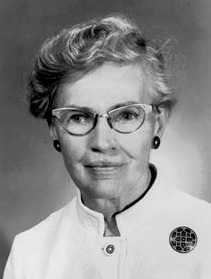Nationality American Role Astronomer | Name Charlotte Sitterly | |
 | ||
Influences Henry Norris RussellBancroft W. Sitterly Died March 3, 1990, Washington, D.C., United States Books Revision of Rowland's Preliminary Table of Solar Spectrum Wave-lengths: With an Extension to the Present Limit of the Infra-red Similar People Henry Norris Russell, Ejnar Hertzsprung, George Darwin | ||
Influenced William Clyde Martin, Jr. | ||
Charlotte Emma Moore Sitterly (September 24, 1898 – March 3, 1990) was an American astronomer. She is known for her extensive spectroscopic studies of the Sun and chemical elements. Her tables of data are known for their reliability and still used regularly.
Contents

Early life and education
Charlotte Moore was born to George W. and Elizabeth Walton Moore in Ercildoun, Pennsylvania, a small village near Coatesville. Her father was the Superintendent of Schools for Chester County and her mother was a schoolteacher. Her parents were Quakers and Charlotte was a lifelong member of Fallowfield Friends Meeting.
She attended Swarthmore College, where she participated in many extracurricular activities such as ice hockey, student government, glee club, and tutoring. In order to pay her tuition, Moore was a substitute teacher. She graduated from Swarthmore in 1920 with a Bachelor of Arts degree in mathematics and went on to Princeton to work as a human computer.
Career
On the recommendation of her mathematics professor at Swarthmore, Moore obtained a job at the Princeton University Observatory working for Professor Henry Norris Russell as a human computer carrying out calculations needed to use photographic plates in determining the position of the Moon. Over time, while working for Russell, Moore's interest in astrophysics began to blossom. Russell and Moore researched binary stars and stellar mass, and published extensively on the subject over the years of their collaboration. Her research included an effort to classify 2500 stars based on their spectra.
After five years at Princeton, as part of an ongoing collaboration between Russell and research groups there, she moved to the Mount Wilson Observatory where she worked extensively on solar spectroscopy, analyzing the spectral lines of the Sun and thereby identifying the chemical elements in the Sun. With her collaborators, she analyzed the spectra of sunspots. Her pictures from the Mount Wilson Observatory helped redetermine the new International Angstrom scale. She earned a Ph.D. in astronomy in 1931 from the University of California, Berkeley on a Lick Fellowship; she was not able to study at Princeton because they did not accept women - and would not for the next 30 years. While working on her Ph.D, she continued researching spectroscopy and collected and analyzed data about the spectra of chemical elements and molecules. After obtaining her Ph.D, she returned to Princeton to continue work with Russell as a research assistant.
One of her most significant contributions to physics was her identification of technetium in sunlight, the first example of technetium naturally existing. She joined the then National Bureau of Standards (NBS) in 1945. Her tables of atomic spectra and energy levels, published by NBS, have remained essential references in spectroscopy for decades. While there, she began to research the infrared solar spectrum and atomic energy levels. Later in her life, it became possible to launch instruments on rockets and she extended her work to the ultraviolet spectral lines.
In 1949 she became the first woman elected as an associate of the Royal Astronomical Society of Great Britain, in honor of her work on multiplet tablets and in identifying solar spot electra. Throughout her career she authored and co-authored over 100 papers and attended the tenth general assembly of the International Astronomical Union on the Joint Commission on Spectroscopy in Moscow in 1958. Sitterly retired from her position at the NBS when she turned 70, in 1968, but continued her research at the Naval Research Laboratory. Sitterly was honored by the Journal of the Optical Society of America by a commemorative issue in 1988.
Personal life
During her second stay at Princeton, she met and married, on May 30, 1937, Bancroft W. Sitterly, who became a physics professor. She continued to publish journals under her maiden name because most of her recognition was under that name. She believed that traveling is one of the most important aspects of a scientist's life, as it promotes collaboration between scientists. She enjoyed gardening, traveling, and music with her husband until his death in 1977. She continued her research until her death from heart failure at the age of 91.
Honors
Awards
Service
Named after her
